What if: Space Shuttle cancellation in 70s
Moderator: Edi
- Uraniun235
- Emperor's Hand
- Posts: 13772
- Joined: 2002-09-12 12:47am
- Location: OREGON
- Contact:
What if: Space Shuttle cancellation in 70s
A time-traveler arrives in the early 1970s and, after somehow convincing everyone of his authenticity, accuracy and honesty, outlines in detail the failures of the Space Shuttle as we know them today.
With the certain knowledge that NASA's (and the Air Force's) plans for STS are fatally flawed, how do you think the United States would respond?
- Revise the Shuttle and attempt to avoid the poor decisions that otherwise would have been made
- Abandon the reusable spaceplane concept, at least initially, and design a next-generation capsule spacecraft
- ...or build another batch of Apollo spacecraft and Saturn rockets to support more Skylab missions?
- Abandon manned spaceflight entirely
- [Something I'm missing?]
The cynic in me wonders if an utterly undeniable "Shuttle is doomed" report would lead to the closure of US manned spaceflight, but maybe not.
With the certain knowledge that NASA's (and the Air Force's) plans for STS are fatally flawed, how do you think the United States would respond?
- Revise the Shuttle and attempt to avoid the poor decisions that otherwise would have been made
- Abandon the reusable spaceplane concept, at least initially, and design a next-generation capsule spacecraft
- ...or build another batch of Apollo spacecraft and Saturn rockets to support more Skylab missions?
- Abandon manned spaceflight entirely
- [Something I'm missing?]
The cynic in me wonders if an utterly undeniable "Shuttle is doomed" report would lead to the closure of US manned spaceflight, but maybe not.
"There is no "taboo" on using nuclear weapons." -Julhelm What is Project Zohar?
What is Project Zohar?
"On a serious note (well not really) I did sometimes jump in and rate nBSG episodes a '5' before the episode even aired or I saw it." - RogueIce explaining that episode ratings on SDN tv show threads are bunk

"On a serious note (well not really) I did sometimes jump in and rate nBSG episodes a '5' before the episode even aired or I saw it." - RogueIce explaining that episode ratings on SDN tv show threads are bunk
- Skgoa
- Jedi Master
- Posts: 1389
- Joined: 2007-08-02 01:39pm
- Location: Dresden, valley of the clueless
Re: What if: Space Shuttle cancellation in 70s
The game hasn't changed just because they now know which parts worked as intended and (most crucially) what went wrong.
The biggest question is whether or not the USAF will continue to invest in the shuttle. If they don't, NASA's human spaceflight program is over. They go back to being america's aerospace research agency, maybe they will even get absorbed by DARPA. The Air Force will continue to use rockets to sent up spy satellites and the soviets will dominate outer space unchallanged.
If somehow the descission is made to continue funding the shuttle, a couple of important things are now known:
1) The thermal tiles can stand up to more punishment than people feared. Thus they can be designed and built bigger, saving a huge amount of money and time in the long run.
2) Turnaround times will not be dictated by the speed at which NASA can refurbish the orbiters, but by how many missions congress doesn't cancel. Desgins can be changed accordingly, most importantly the "standing army" can be reduced even further.
3) Orbiters will remain active far longer, but fly far less mission, than expected. Designs will be changed to reflect this.
4) Since all technical defects and limits are known, the Shuttle will have a remarkably untarnished launch history.
The real question is what the president at the time thinks. NASA has always had a huge amount of meddling by politicians and it can't decide policy for itself. If the president removes some of the Air Force's more insane requirements, the Shuttle and NASA will be in an even better position for human spaceflight.
The biggest question is whether or not the USAF will continue to invest in the shuttle. If they don't, NASA's human spaceflight program is over. They go back to being america's aerospace research agency, maybe they will even get absorbed by DARPA. The Air Force will continue to use rockets to sent up spy satellites and the soviets will dominate outer space unchallanged.
If somehow the descission is made to continue funding the shuttle, a couple of important things are now known:
1) The thermal tiles can stand up to more punishment than people feared. Thus they can be designed and built bigger, saving a huge amount of money and time in the long run.
2) Turnaround times will not be dictated by the speed at which NASA can refurbish the orbiters, but by how many missions congress doesn't cancel. Desgins can be changed accordingly, most importantly the "standing army" can be reduced even further.
3) Orbiters will remain active far longer, but fly far less mission, than expected. Designs will be changed to reflect this.
4) Since all technical defects and limits are known, the Shuttle will have a remarkably untarnished launch history.
The real question is what the president at the time thinks. NASA has always had a huge amount of meddling by politicians and it can't decide policy for itself. If the president removes some of the Air Force's more insane requirements, the Shuttle and NASA will be in an even better position for human spaceflight.
http://www.politicalcompass.org/test
Economic Left/Right: -7.12
Social Libertarian/Authoritarian: -7.74
This is pre-WWII. You can sort of tell from the sketch style, from thee way it refers to Japan (Japan in the 1950s was still rebuilding from WWII), the spelling of Tokyo, lots of details. Nothing obvious... except that the upper right hand corner of the page reads "November 1931." --- Simon_Jester
Economic Left/Right: -7.12
Social Libertarian/Authoritarian: -7.74
This is pre-WWII. You can sort of tell from the sketch style, from thee way it refers to Japan (Japan in the 1950s was still rebuilding from WWII), the spelling of Tokyo, lots of details. Nothing obvious... except that the upper right hand corner of the page reads "November 1931." --- Simon_Jester
- Big Orange
- Emperor's Hand
- Posts: 7108
- Joined: 2006-04-22 05:15pm
- Location: Britain
Re: What if: Space Shuttle cancellation in 70s
The Shuttle seemed to have been largely based on the X-20 Dyna-Soar, a military space plane that could be launched into space on the nose of a Titan III rocket and drop nukes from orbit!Skgoa wrote:If the president removes some of the Air Force's more insane requirements, the Shuttle and NASA will be in an even better position for human spaceflight.
The US Air Force, Navy, and even Army seemed to be doing well enough with space rocketry before NASA was formed shortly following the launch of Sputnik - although too ambitious, the US Army in the 1950s was planning on builiding a moon base and more realistically got close to usurping the ICBM program from its US Air Force rivals.
I guess the ostensibly civilian National Aeronautics and Space Administration was intended as an agency that conducted space exploration without overtly provoking the Soviets (with men on the moon done more for science and exploration, rather than for seeking a militaristic advantage).
'Alright guard, begin the unnecessarily slow moving dipping mechanism...' - Dr. Evil
'Secondly, I don't see why "income inequality" is a bad thing. Poverty is not an injustice. There is no such thing as causes for poverty, only causes for wealth. Poverty is not a wrong, but taking money from those who have it to equalize incomes is basically theft, which is wrong.' - Typical Randroid
'I think it's gone a little bit wrong.' - The Doctor
'Secondly, I don't see why "income inequality" is a bad thing. Poverty is not an injustice. There is no such thing as causes for poverty, only causes for wealth. Poverty is not a wrong, but taking money from those who have it to equalize incomes is basically theft, which is wrong.' - Typical Randroid
'I think it's gone a little bit wrong.' - The Doctor
-
Pelranius
- Sith Marauder
- Posts: 3539
- Joined: 2006-10-24 11:35am
- Location: Around and about the Beltway
Re: What if: Space Shuttle cancellation in 70s
That was a large part of the rationale for NASA's creation, and also to get NACA more involved in space.Big Orange wrote: I guess the ostensibly civilian National Aeronautics and Space Administration was intended as an agency that conducted space exploration without overtly provoking the Soviets (with men on the moon done more for science and exploration, rather than for seeking a militaristic advantage).
The problem for military manned space flight is that they couldn't (and still can't) think of very many rationales for putting a man into space assets, unless you want to do nukes (but those were already banned by a 1960s treaty).
Turns out that a five way cross over between It's Always Sunny in Philadelphia, the Ali G Show, Fargo, Idiocracy and Veep is a lot less funny when you're actually living in it.
- MKSheppard
- Ruthless Genocidal Warmonger

- Posts: 29877
- Joined: 2002-07-06 06:34pm
Re: What if: Space Shuttle cancellation in 70s
The Space Shuttle cost us $36,192~ million in FY2010 dollars from 1970-1981.
By contrast, Study of an Evolutionary Interim Earth Orbit Program from 6 April 1971 gave costs for program restarts as being:
Production Restarts:
Saturn IB: $376.89 million in 2010 Dollars
S-IVB Production: $161.52 million in 2010 Dollars
S-IC/S-II Production (for INT-21): $699.93 million in 2010 Dollars
Apollo CSM Production: $538.41 million in 2010 Dollars
Titan IIIM Restart + Man-Rating + Apollo Spacecraft Adapter: $1,346 million in 2010 dollars
Once the production lines had been restarted or the hardware developed, the procurement costs would have been about:
Titan IIIM Costs: $134.60 million in 2010 Dollars
Saturn IB Costs: $269.20 million in 2010 Dollars
Saturn INT-21 Costs: $430.73 million in 2010 Dollars
Apollo CSM Costs: $242.28 million in 2010 Dollars
There's a good reason to go with Saturn IB over Titan IIIM, namely, the 46,000~ lb to LEO capability of the Saturn IB (Skylab 4 CSM Mass), versus the 26,300 lb of the Titan IIIM.
So what would a LEO-only Block III Apollo CSM have looked like if it had been decided to continue use of Apollo/Saturn technology in January 1972 instead of going with the Space Shuttle?
We have an idea from some GRAEPHS done in the late 1960s.
The MODAP Logistics CSM according to Modified Apollo Logistics Spacecraft: Final Technical Presentation (SID 63-1459) would have weighed 19,973~ lbs (*) and had the capability of:
6-Man Crew Transport to/from Space Station
6 Month Docked Stowage connected to Space Station
Transporting 7,157 lbs of cargo in cargo containers in four Service Module Bays where propellant used to be.
These containers would have massed 1,970 lbs. This would provide a 45-day resupply for a space station.
Cargo Bay Door opening would have been through using shaped charges on three sides, with the fourth side having hinges.
It sounds crazy, but a similar technique was used to blow off the SIM Bay on the J missions CSMs.
Cargo transfer would have been accomplished through using a mechanical arm to move individual containers into a smaller cargo transfer airlock on the station and/or via connecting a hose to allow for liquid cargo transfer.
[NOTE FOR * : This weight is for the spacecraft without cargo or cargo containers. Additionally, a 3,400~ lb Spacecraft Adapter would have been needed to adapt it to either Saturn IB or Titan IIIC.]
Significant changes other than reducing propellant tankage and cargo bay conversions that stand out to me are:
* SPS replaced with LEM Descent Engine. This would have cost the government only $95,000 USD versus $320,000 for SPS.
* Fuel Cells (1,450~ lb) were replaced with Batteries (600~ lbs). It's worth noting that NAA pointed out that if H2 boil off issues over six months of storage were resolved satisfactorily, a fuel cell system weighing only 320~ lbs could do the job.
* 570~ lb reduction in Heat shield mass due to lesser heating load from orbital re-entry vs lunar re-entry.
* Using a solid motor retro-rocket package similar to that on Mercury for orbital deboosting of the CM -- it would have massed 1,268 pounds. It makes sense; because you don't have to deboost the entire CSM -- just the CM. But this means additional R&DTE and further changes to the Service Module, so we can delete it and just eat the reduced cargo load if cost is a concern.
* Retros would have been added integral to the CM to allow a minimal earth-landing capability -- though water landing would still be the prime landing mode. This could be eliminated for lesser R&DTE.
If MODAP had been approved sometime in 1964, operational flights would have occured in July 1968; roughly some 55~ months after ATP.
Total costs to develop the MODAP CSM and provide 49 flight articles would have been $12,280 million in 2010 dollars.
The biggest problem is going to be the delay that was imposed by the cancellations of 1968 and the time wasted until 1972.
In SP-4011, SKYLAB: A CHRONOLOGY, it mentions that on 18-19 July 1972; the SL-2 CSM was shipped to KSC -- that was CSM-116. Generally the CSMs arrived at KSC a day or so after they were ready for delivery at the factory.
Unfortunately, I haven't been able to find further information on CSM-117/118/119.
This does indicate that the Apollo production infrastructure was not yet quite totally shut down by January 1972; which means that it's plausible to reduce Block III operational availability from ATP to about 48~ months.
(Remember, you need to give a bone to to the Space Industrial Complex; and being able to update subsystems from their basic 1966-1968 technology level to a 1972-73 technological level would be more interesting to the engineers than a simple re-ordering of Block II.)
Development times for Saturn V variants ranged from 24 months for the INT-20 and -21, to 64 to 70 months for some of the more exotic variants; and those were assuming that a decision to develop them were made before Saturn V production shut down.
I think it's fairly safe to assume that even minor changes like implementing J-2S engines and simplifications based on operational experience for a Block II production run of Saturn Vs would require 48 months from ATP.
Furthermore, even if we stuck to our guns and held the changes for a Block III CSM to a minimum, such as using developed subsystems, like the LEM DPS wherever possible; and keeping changes within reasonable bounds, such as a new Block III AGC that takes advantage of computing developments since 1964 to shrink weight, volume and power consumption, while offering more computing power, it'd be reasonable to assume it would still take 55~ months.
This would mean that it would take until December 1975 for Saturn VB lifting capability to be available to mission planners on a reliable basis; and July 1976 before manned flights can resume.
Hey, that's a good one for an alt-hist story -- the 4 July 1976 launch of the Skylab 5 Manned Reboost Mission from LC-39A, while LC-39B launches a few hours later the Viking nuclear powered rover for a landing date of 4 July 1977 on MARS.
By contrast, Study of an Evolutionary Interim Earth Orbit Program from 6 April 1971 gave costs for program restarts as being:
Production Restarts:
Saturn IB: $376.89 million in 2010 Dollars
S-IVB Production: $161.52 million in 2010 Dollars
S-IC/S-II Production (for INT-21): $699.93 million in 2010 Dollars
Apollo CSM Production: $538.41 million in 2010 Dollars
Titan IIIM Restart + Man-Rating + Apollo Spacecraft Adapter: $1,346 million in 2010 dollars
Once the production lines had been restarted or the hardware developed, the procurement costs would have been about:
Titan IIIM Costs: $134.60 million in 2010 Dollars
Saturn IB Costs: $269.20 million in 2010 Dollars
Saturn INT-21 Costs: $430.73 million in 2010 Dollars
Apollo CSM Costs: $242.28 million in 2010 Dollars
There's a good reason to go with Saturn IB over Titan IIIM, namely, the 46,000~ lb to LEO capability of the Saturn IB (Skylab 4 CSM Mass), versus the 26,300 lb of the Titan IIIM.
So what would a LEO-only Block III Apollo CSM have looked like if it had been decided to continue use of Apollo/Saturn technology in January 1972 instead of going with the Space Shuttle?
We have an idea from some GRAEPHS done in the late 1960s.
The MODAP Logistics CSM according to Modified Apollo Logistics Spacecraft: Final Technical Presentation (SID 63-1459) would have weighed 19,973~ lbs (*) and had the capability of:
6-Man Crew Transport to/from Space Station
6 Month Docked Stowage connected to Space Station
Transporting 7,157 lbs of cargo in cargo containers in four Service Module Bays where propellant used to be.
These containers would have massed 1,970 lbs. This would provide a 45-day resupply for a space station.
Cargo Bay Door opening would have been through using shaped charges on three sides, with the fourth side having hinges.
It sounds crazy, but a similar technique was used to blow off the SIM Bay on the J missions CSMs.
Cargo transfer would have been accomplished through using a mechanical arm to move individual containers into a smaller cargo transfer airlock on the station and/or via connecting a hose to allow for liquid cargo transfer.
[NOTE FOR * : This weight is for the spacecraft without cargo or cargo containers. Additionally, a 3,400~ lb Spacecraft Adapter would have been needed to adapt it to either Saturn IB or Titan IIIC.]
Significant changes other than reducing propellant tankage and cargo bay conversions that stand out to me are:
* SPS replaced with LEM Descent Engine. This would have cost the government only $95,000 USD versus $320,000 for SPS.
* Fuel Cells (1,450~ lb) were replaced with Batteries (600~ lbs). It's worth noting that NAA pointed out that if H2 boil off issues over six months of storage were resolved satisfactorily, a fuel cell system weighing only 320~ lbs could do the job.
* 570~ lb reduction in Heat shield mass due to lesser heating load from orbital re-entry vs lunar re-entry.
* Using a solid motor retro-rocket package similar to that on Mercury for orbital deboosting of the CM -- it would have massed 1,268 pounds. It makes sense; because you don't have to deboost the entire CSM -- just the CM. But this means additional R&DTE and further changes to the Service Module, so we can delete it and just eat the reduced cargo load if cost is a concern.
* Retros would have been added integral to the CM to allow a minimal earth-landing capability -- though water landing would still be the prime landing mode. This could be eliminated for lesser R&DTE.
If MODAP had been approved sometime in 1964, operational flights would have occured in July 1968; roughly some 55~ months after ATP.
Total costs to develop the MODAP CSM and provide 49 flight articles would have been $12,280 million in 2010 dollars.
The biggest problem is going to be the delay that was imposed by the cancellations of 1968 and the time wasted until 1972.
In SP-4011, SKYLAB: A CHRONOLOGY, it mentions that on 18-19 July 1972; the SL-2 CSM was shipped to KSC -- that was CSM-116. Generally the CSMs arrived at KSC a day or so after they were ready for delivery at the factory.
Unfortunately, I haven't been able to find further information on CSM-117/118/119.
This does indicate that the Apollo production infrastructure was not yet quite totally shut down by January 1972; which means that it's plausible to reduce Block III operational availability from ATP to about 48~ months.
(Remember, you need to give a bone to to the Space Industrial Complex; and being able to update subsystems from their basic 1966-1968 technology level to a 1972-73 technological level would be more interesting to the engineers than a simple re-ordering of Block II.)
Development times for Saturn V variants ranged from 24 months for the INT-20 and -21, to 64 to 70 months for some of the more exotic variants; and those were assuming that a decision to develop them were made before Saturn V production shut down.
I think it's fairly safe to assume that even minor changes like implementing J-2S engines and simplifications based on operational experience for a Block II production run of Saturn Vs would require 48 months from ATP.
Furthermore, even if we stuck to our guns and held the changes for a Block III CSM to a minimum, such as using developed subsystems, like the LEM DPS wherever possible; and keeping changes within reasonable bounds, such as a new Block III AGC that takes advantage of computing developments since 1964 to shrink weight, volume and power consumption, while offering more computing power, it'd be reasonable to assume it would still take 55~ months.
This would mean that it would take until December 1975 for Saturn VB lifting capability to be available to mission planners on a reliable basis; and July 1976 before manned flights can resume.
Hey, that's a good one for an alt-hist story -- the 4 July 1976 launch of the Skylab 5 Manned Reboost Mission from LC-39A, while LC-39B launches a few hours later the Viking nuclear powered rover for a landing date of 4 July 1977 on MARS.
"If scientists and inventors who develop disease cures and useful technologies don't get lifetime royalties, I'd like to know what fucking rationale you have for some guy getting lifetime royalties for writing an episode of Full House." - Mike Wong
"The present air situation in the Pacific is entirely the result of fighting a fifth rate air power." - U.S. Navy Memo - 24 July 1944
"The present air situation in the Pacific is entirely the result of fighting a fifth rate air power." - U.S. Navy Memo - 24 July 1944
- MKSheppard
- Ruthless Genocidal Warmonger

- Posts: 29877
- Joined: 2002-07-06 06:34pm
Re: What if: Space Shuttle cancellation in 70s
Also, there is the hand of NIXON [tm] on the Space Program.
While he was not as much of a Space Cadet [tm] as Johnson was, he still liked the Space Program, and genuinely liked it when the Astronauts came to visit the White House, and got Frank Borman to work there briefly.
One of the most notable memorandums dealing with the Space Shuttle is this one from Cap Weinberger to Nixon:
HTMLed version
PDF Original
It's worth reading that; to see Nixon's markups; what he underlined, and of course his "I AGREE WITH CAP" notation.
This led to his "Voyage" speech: Link
Nixon worked personally on this speech, making his own alterations, rather than taking the original from his speechwriters and delivering it straight with no alterations.
It concludes with:
“We must sail sometimes with the wind and sometimes against it,” said Oliver Wendell Holmes, “but we must sail, and not drift, nor lie at anchor.” So with man’s epic voyage into space -- a voyage the United States of America has led and still shall lead.
While he was not as much of a Space Cadet [tm] as Johnson was, he still liked the Space Program, and genuinely liked it when the Astronauts came to visit the White House, and got Frank Borman to work there briefly.
One of the most notable memorandums dealing with the Space Shuttle is this one from Cap Weinberger to Nixon:
HTMLed version
PDF Original
It's worth reading that; to see Nixon's markups; what he underlined, and of course his "I AGREE WITH CAP" notation.
This led to his "Voyage" speech: Link
Nixon worked personally on this speech, making his own alterations, rather than taking the original from his speechwriters and delivering it straight with no alterations.
It concludes with:
“We must sail sometimes with the wind and sometimes against it,” said Oliver Wendell Holmes, “but we must sail, and not drift, nor lie at anchor.” So with man’s epic voyage into space -- a voyage the United States of America has led and still shall lead.
"If scientists and inventors who develop disease cures and useful technologies don't get lifetime royalties, I'd like to know what fucking rationale you have for some guy getting lifetime royalties for writing an episode of Full House." - Mike Wong
"The present air situation in the Pacific is entirely the result of fighting a fifth rate air power." - U.S. Navy Memo - 24 July 1944
"The present air situation in the Pacific is entirely the result of fighting a fifth rate air power." - U.S. Navy Memo - 24 July 1944
- Uraniun235
- Emperor's Hand
- Posts: 13772
- Joined: 2002-09-12 12:47am
- Location: OREGON
- Contact:
Re: What if: Space Shuttle cancellation in 70s
On the other hand, one of the major selling points of the Space Shuttle was that it would be so quick to turn around and so cheap to launch that we would use it for all satellite launch needs, both military and civilian. The drive for a reusable spacecraft will be much reduced when in the alternate timeline we will continue to launch commercial and (many) military satellites via unmanned disposable rocket.Skgoa wrote: 2) Turnaround times will not be dictated by the speed at which NASA can refurbish the orbiters, but by how many missions congress doesn't cancel. Desgins can be changed accordingly, most importantly the "standing army" can be reduced even further.
"There is no "taboo" on using nuclear weapons." -Julhelm What is Project Zohar?
What is Project Zohar?
"On a serious note (well not really) I did sometimes jump in and rate nBSG episodes a '5' before the episode even aired or I saw it." - RogueIce explaining that episode ratings on SDN tv show threads are bunk

"On a serious note (well not really) I did sometimes jump in and rate nBSG episodes a '5' before the episode even aired or I saw it." - RogueIce explaining that episode ratings on SDN tv show threads are bunk
- Uraniun235
- Emperor's Hand
- Posts: 13772
- Joined: 2002-09-12 12:47am
- Location: OREGON
- Contact:
Re: What if: Space Shuttle cancellation in 70s
Interesting how the procurement cost and payload capacity seem to scale almost linearly between Titan and Saturn IB. Then INT-21 appears and annihilates them both.MKSheppard wrote:The Space Shuttle cost us $36,192~ million in FY2010 dollars from 1970-1981.
By contrast, Study of an Evolutionary Interim Earth Orbit Program from 6 April 1971 gave costs for program restarts as being:
Production Restarts:
Saturn IB: $376.89 million in 2010 Dollars
S-IVB Production: $161.52 million in 2010 Dollars
S-IC/S-II Production (for INT-21): $699.93 million in 2010 Dollars
Apollo CSM Production: $538.41 million in 2010 Dollars
Titan IIIM Restart + Man-Rating + Apollo Spacecraft Adapter: $1,346 million in 2010 dollars
Once the production lines had been restarted or the hardware developed, the procurement costs would have been about:
Titan IIIM Costs: $134.60 million in 2010 Dollars
Saturn IB Costs: $269.20 million in 2010 Dollars
Saturn INT-21 Costs: $430.73 million in 2010 Dollars
Apollo CSM Costs: $242.28 million in 2010 Dollars
There's a good reason to go with Saturn IB over Titan IIIM, namely, the 46,000~ lb to LEO capability of the Saturn IB (Skylab 4 CSM Mass), versus the 26,300 lb of the Titan IIIM.
Was there ever a proposal to try and load/deploy multiple satellite payloads from a single -21?
The impression I got was that Skylab was already not in great shape and would have required substantial refurbishment and resupply which it hadn't really been designed to accommodate in space. Maybe upgrading the second, unflown Skylab for greater serviceability and launching it would have been a better approach.This would mean that it would take until December 1975 for Saturn VB lifting capability to be available to mission planners on a reliable basis; and July 1976 before manned flights can resume.
Hey, that's a good one for an alt-hist story -- the 4 July 1976 launch of the Skylab 5 Manned Reboost Mission from LC-39A, while LC-39B launches a few hours later the Viking nuclear powered rover for a landing date of 4 July 1977 on MARS.
"There is no "taboo" on using nuclear weapons." -Julhelm What is Project Zohar?
What is Project Zohar?
"On a serious note (well not really) I did sometimes jump in and rate nBSG episodes a '5' before the episode even aired or I saw it." - RogueIce explaining that episode ratings on SDN tv show threads are bunk

"On a serious note (well not really) I did sometimes jump in and rate nBSG episodes a '5' before the episode even aired or I saw it." - RogueIce explaining that episode ratings on SDN tv show threads are bunk
- MKSheppard
- Ruthless Genocidal Warmonger

- Posts: 29877
- Joined: 2002-07-06 06:34pm
Re: What if: Space Shuttle cancellation in 70s
Probably. The VOYAGER Mars probe project would have deployed multiple landers on a single Saturn V:Uraniun235 wrote:Was there ever a proposal to try and load/deploy multiple satellite payloads from a single -21?
Link
Northrop's "most promising" AMSSR mission design included one orbiter/bus spacecraft, two AMSSR landers with ascent vehicles, and two rovers. The orbiter/bus would carry the two landers, each of which would carry one rover. The five vehicles would have a combined mass of 74 tons at launch from Earth on a modified Saturn V. Modifications to the basic Apollo Saturn V design would include a new third stage equipped with a NERVA nuclear-thermal rocket engine.
Following arrival in Earth orbit, the NERVA third stage would boost the AMSSR vehicles toward Mars on a low-energy conjunction-class trajectory. This would require a stay at Mars lasting from 340 to 420 days so that the planets could line up for a low-energy Mars-Earth transfer.
After a six-month interplanetary cruise, the orbiter/bus would fire a rocket to slow down so Mars's gravity could capture it into a circular orbit. The orbiter would image the surface from on high to enable scientists and engineers to make final landing site selections. The twin landers would then separate and fire rocket motors to slow down. They would enter the martian atmosphere on a ballistic path (that is, they would make no use of aerodynamic lift) and would touch down at widely separated sites. During descent, they would collect samples of martian air at different altitudes.
Odom's team rejected as insufficiently capable a 100-pound sample-collection rover tied to its lander by a 100-meter umbilical cable. Each of the AMSSR mission's 1200-pound rovers would travel several kilometers from its lander to collect samples and return them to their respective lander's ascent vehicle.
The landers, meanwhile, would scoop surface samples and drill subsurface samples. Northrop calculated that about 2.7 kilograms of samples would be sufficient for three users (biology team, physical sciences team, and "archives"). Citing the demand for Apollo 11 lunar samples from scientists around the world, however, the company recommended that at least 10 kilograms of Mars be returned to Earth. The orbiter/bus, meanwhile, would photograph all of Mars in color at medium resolution and selected areas at high resolution.
The twin ascent vehicles would each launch up to 51 pounds of samples into circular Mars orbit, then the orbiter/bus would perform rendezvous and docking them in turn to collect their samples. After casting off the spent ascent vehicles, the orbiter/bus would fire its main engine to begin the voyage home to Earth.
Skylab B eh?Maybe upgrading the second, unflown Skylab for greater serviceability and launching it would have been a better approach.
I've done some thinking about what would have followed Skylab if we hadn't retired the Saturn V.
Keep in mind that Skylab A/B were very much done on the cheap, via converting S-IVB-212 to Skylab A and S-IVB-515 to Skylab B, to reduce development costs.
Starting from a slightly more blank slate, Skylab C and D could have offered slightly more interior space and more consumables; since the design could be more optimal, rather than being totally constrained by the tank dimensions of the S-IVB to minimize developmental costs.
Beyond that; there are some very impressive things you could do with a modular space station with the Saturn V's lifting capability -- STUDY OF AN EVOLUTIONARY INTERIM EARTH ORBIT PROGRAM, dated 6 April 1971 gives the payload parameters for a two stage Saturn V to the orbital parameter of 235 nautical miles high and 50 degree inclination used by Skylab as being 197,000 pounds -- actual payload to that position would remain at 170,000~ lbs to account for shroud mass and to provide a safety margin in case of an underperforming booster.
If you adopted the ISS' architecture of dedicated modules for power/life support/research, you could do really awesome things with a hypothetical follow on Skylab E.
Such as launching a S-IVB based/sized module to provide electrical power, life support, and attitude control, etc for Skylab E; and then following it up with a S-II sized module for living quarters and experiments.
It's certainly possible to put a S-II sized module up -- the dry mass of S-II-11 was 80,362 lbs; while S-II-13 was 80,463 lbs.
It won't be as dense as Skylab, so it makes sense to chain it up with a smaller, more dense module which provides hotel power.
According to "Description of S-II Stage Structures" from 20 April 1967; the S-II's LH2 tank was 36,883 cubic feet; which means a S-IVB + S-II station would have a pressurized volume of about 45,000~ cubic feet.
Contrast this to the 32,000~ cubic feet ISS will have when the last major module is docked in 2012.
Assembly costs would be massively lower too, you'd only have to pay for two Saturn INT-21 launches, which would have cost only $861~ million to fire off, versus the roughly $14,400 million needed for the 36 shuttle missions which delivered components to ISS and had spacewalks occur while docked to the ISS.
"If scientists and inventors who develop disease cures and useful technologies don't get lifetime royalties, I'd like to know what fucking rationale you have for some guy getting lifetime royalties for writing an episode of Full House." - Mike Wong
"The present air situation in the Pacific is entirely the result of fighting a fifth rate air power." - U.S. Navy Memo - 24 July 1944
"The present air situation in the Pacific is entirely the result of fighting a fifth rate air power." - U.S. Navy Memo - 24 July 1944
- MKSheppard
- Ruthless Genocidal Warmonger

- Posts: 29877
- Joined: 2002-07-06 06:34pm
Re: What if: Space Shuttle cancellation in 70s
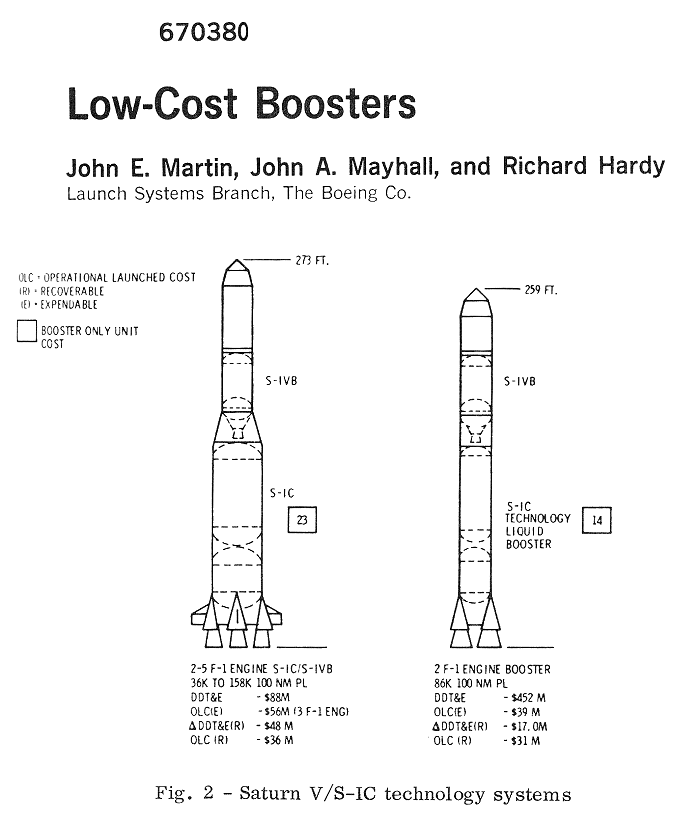
RP-1/LOX (PUMP-FED)/S-IVB VEHICLE
The other Saturn V/S-IC derivative vehicle examined is a 260-inch diameter RP-1/LOX stage combined with an S-IVB as a second stage, see Figure 2.
One hundred N.M. circular orbit payload for this combination is 86,000 pounds.
The first stage has two F-1 engines identical with those used on Saturn V.
Booster subsystems are either existing Saturn V/S-IC elements or are a direct application of the current design and manufacturing techniques.
The primary structural material is 2219-T-87 Aluminum - proven on the S-IC (Figure 7 describes material properties).
The S-IVB stage is the same as that presently used on uprated Saturn I.
Development cost for this vehicle is estimated to be approximately 452 million dollars including two man-rating flights, construction of manufacturing and test facilities, engineering, tooling, etc. and modification of the Saturn IB launch facility to handle this new vehicle. The operational vehicle "launched" cost is estimated as 39 million dollars.
Recovery and reuse of this vehicle would use the S-IC concept (Figure 3). Additional DDT&E would be approximately 17 million dollars and the average "launched" cost would reduce to 31 million dollars.
NOTE: Costs are from 1967. In today's money (2010) they'd be:
Development: $2,951~ million
Launched Cost: $255~ million
Basically, cheaper than Saturn IB, but putting twice the payload into orbit.
"If scientists and inventors who develop disease cures and useful technologies don't get lifetime royalties, I'd like to know what fucking rationale you have for some guy getting lifetime royalties for writing an episode of Full House." - Mike Wong
"The present air situation in the Pacific is entirely the result of fighting a fifth rate air power." - U.S. Navy Memo - 24 July 1944
"The present air situation in the Pacific is entirely the result of fighting a fifth rate air power." - U.S. Navy Memo - 24 July 1944
- Sea Skimmer
- Yankee Capitalist Air Pirate
- Posts: 37390
- Joined: 2002-07-03 11:49pm
- Location: Passchendaele City, HAB
Re: What if: Space Shuttle cancellation in 70s
Its not, the two are very different. Some proposals for small two man shuttles were a tad bit like X-20 in configuration, but the shuttle was we know it is not. NASA and the air force flew a whole lot of unmanned and manned lifting bodies well after X-20 died like X-24 and HL-10 that have far more to do with the actual spacecraft.Big Orange wrote: The Shuttle seemed to have been largely based on the X-20 Dyna-Soar, a military space plane that could be launched into space on the nose of a Titan III rocket and drop nukes from orbit!
"This cult of special forces is as sensible as to form a Royal Corps of Tree Climbers and say that no soldier who does not wear its green hat with a bunch of oak leaves stuck in it should be expected to climb a tree"
— Field Marshal William Slim 1956
— Field Marshal William Slim 1956
- Uraniun235
- Emperor's Hand
- Posts: 13772
- Joined: 2002-09-12 12:47am
- Location: OREGON
- Contact:
Re: What if: Space Shuttle cancellation in 70s
Wow!MKSheppard wrote: Recovery and reuse of this vehicle would use the S-IC concept (Figure 3). Additional DDT&E would be approximately 17 million dollars and the average "launched" cost would reduce to 31 million dollars.[/i]
...
NOTE: Costs are from 1967. In today's money (2010) they'd be:
Development: $2,951~ million
Launched Cost: $255~ million
Basically, cheaper than Saturn IB, but putting twice the payload into orbit.
When they mention recoverable, is that like how the Shuttle SRBs were recovered and reused?
I know it may not be coming across in my short responses, but this is all very fascinating. This is basically what I was hoping for when I posted the thread.
"There is no "taboo" on using nuclear weapons." -Julhelm What is Project Zohar?
What is Project Zohar?
"On a serious note (well not really) I did sometimes jump in and rate nBSG episodes a '5' before the episode even aired or I saw it." - RogueIce explaining that episode ratings on SDN tv show threads are bunk

"On a serious note (well not really) I did sometimes jump in and rate nBSG episodes a '5' before the episode even aired or I saw it." - RogueIce explaining that episode ratings on SDN tv show threads are bunk
- MKSheppard
- Ruthless Genocidal Warmonger

- Posts: 29877
- Joined: 2002-07-06 06:34pm
Re: What if: Space Shuttle cancellation in 70s
Sorta.Uraniun235 wrote:When they mention recoverable, is that like how the Shuttle SRBs were recovered and reused?

You blow off the tank dome and use the stage as a giant crushable can to ensure that the engines remain largely intact upon water-reentry.
Admit it, you just wanted GRAEPHS.I know it may not be coming across in my short responses, but this is all very fascinating. This is basically what I was hoping for when I posted the thread.
"If scientists and inventors who develop disease cures and useful technologies don't get lifetime royalties, I'd like to know what fucking rationale you have for some guy getting lifetime royalties for writing an episode of Full House." - Mike Wong
"The present air situation in the Pacific is entirely the result of fighting a fifth rate air power." - U.S. Navy Memo - 24 July 1944
"The present air situation in the Pacific is entirely the result of fighting a fifth rate air power." - U.S. Navy Memo - 24 July 1944
- MKSheppard
- Ruthless Genocidal Warmonger

- Posts: 29877
- Joined: 2002-07-06 06:34pm
Re: What if: Space Shuttle cancellation in 70s
MLV Saturn IB-5A
Step 1.) Take Saturn IB.
Step 2.) Replace S-IB first stage with a 260" diameter SRB. (Shuttle SRB is 156" diameter, BTW)
Step 3.) Ares I 30 years early!
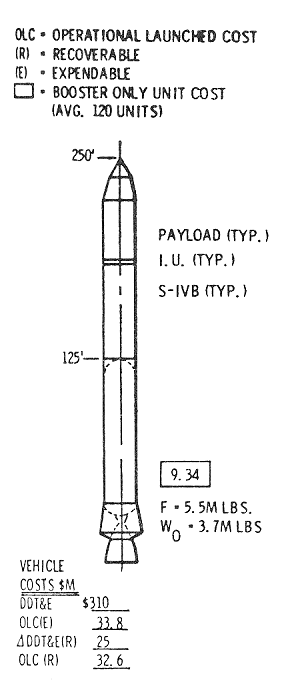
Essentially:
5.5 mlbf of thrust from this thing, compared to 2.8-3.1 mlbf for a Shuttle SRB; and it would place the same payload as that F-1 booster -- some 86,000 lbs into LEO.
Cost would be
$2,024~ million in development (add $163~ million if you want to recover it like a shuttle booster)
$220.6~ million per launch ($212.8 if it's partially recoverable)
This is actually feasible, BTW.
Aerojet built a factory in Florida in the Everglades specifically to construct 260 inch Solid Rocket Motors; and they actually built a motor segment and test fired it:
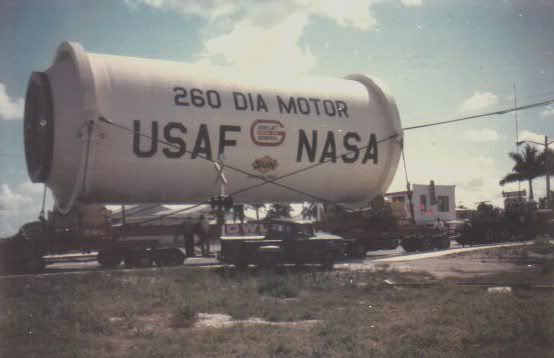
AJ-260 on flatbed
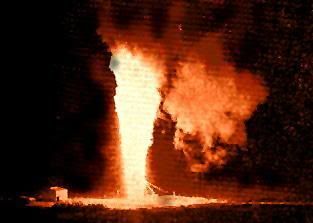
AJ-260 test firing
It's why I laugh, fucking laugh, as it were, when Obama talks about developing 'new technology' in his space speeches.
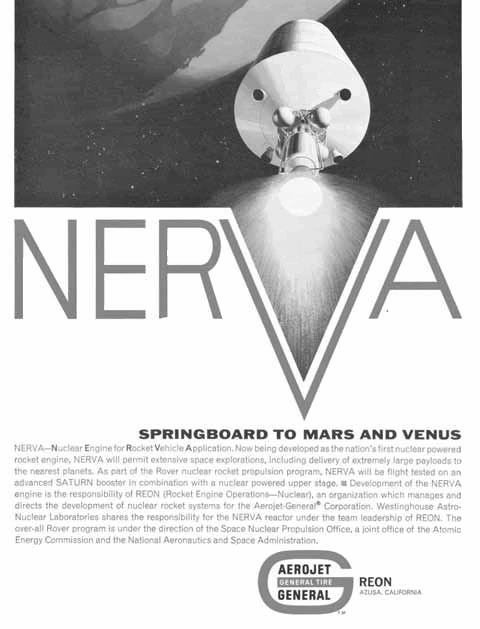
NERVA II costs a billion plus. That can buy 375,000 schoolrooms. I know I'll be blasted back home because California gets fifty percent of the space contracts but how do I tell my people their kids can't have classrooms, but we're going to Mars. Adding the military, we're spending seven billion on Space. Can't we take a billion of it for domestic programs?
--Congressman Chester E. Holifield, D-California.
Step 1.) Take Saturn IB.
Step 2.) Replace S-IB first stage with a 260" diameter SRB. (Shuttle SRB is 156" diameter, BTW)
Step 3.) Ares I 30 years early!

Essentially:
5.5 mlbf of thrust from this thing, compared to 2.8-3.1 mlbf for a Shuttle SRB; and it would place the same payload as that F-1 booster -- some 86,000 lbs into LEO.
Cost would be
$2,024~ million in development (add $163~ million if you want to recover it like a shuttle booster)
$220.6~ million per launch ($212.8 if it's partially recoverable)
This is actually feasible, BTW.
Aerojet built a factory in Florida in the Everglades specifically to construct 260 inch Solid Rocket Motors; and they actually built a motor segment and test fired it:

AJ-260 on flatbed

AJ-260 test firing
It's why I laugh, fucking laugh, as it were, when Obama talks about developing 'new technology' in his space speeches.

NERVA II costs a billion plus. That can buy 375,000 schoolrooms. I know I'll be blasted back home because California gets fifty percent of the space contracts but how do I tell my people their kids can't have classrooms, but we're going to Mars. Adding the military, we're spending seven billion on Space. Can't we take a billion of it for domestic programs?
--Congressman Chester E. Holifield, D-California.
"If scientists and inventors who develop disease cures and useful technologies don't get lifetime royalties, I'd like to know what fucking rationale you have for some guy getting lifetime royalties for writing an episode of Full House." - Mike Wong
"The present air situation in the Pacific is entirely the result of fighting a fifth rate air power." - U.S. Navy Memo - 24 July 1944
"The present air situation in the Pacific is entirely the result of fighting a fifth rate air power." - U.S. Navy Memo - 24 July 1944
- MKSheppard
- Ruthless Genocidal Warmonger

- Posts: 29877
- Joined: 2002-07-06 06:34pm
Re: What if: Space Shuttle cancellation in 70s
Ok, so you want to know what if you get if you go fucking insane and give NASA/DoD a blank check?
This was from a study in the late 1970s that was presented in 1979 formally.
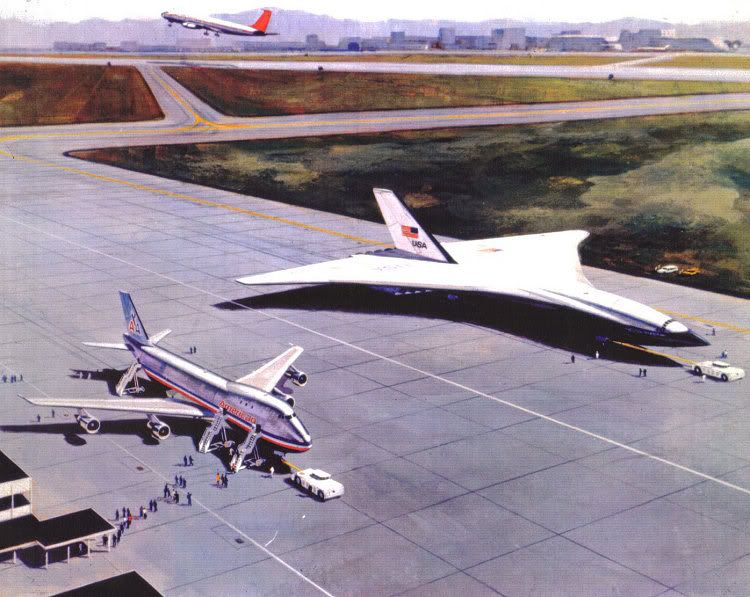
Lockheed Star-Raker and 747 at airport

Star-Raker payload operations
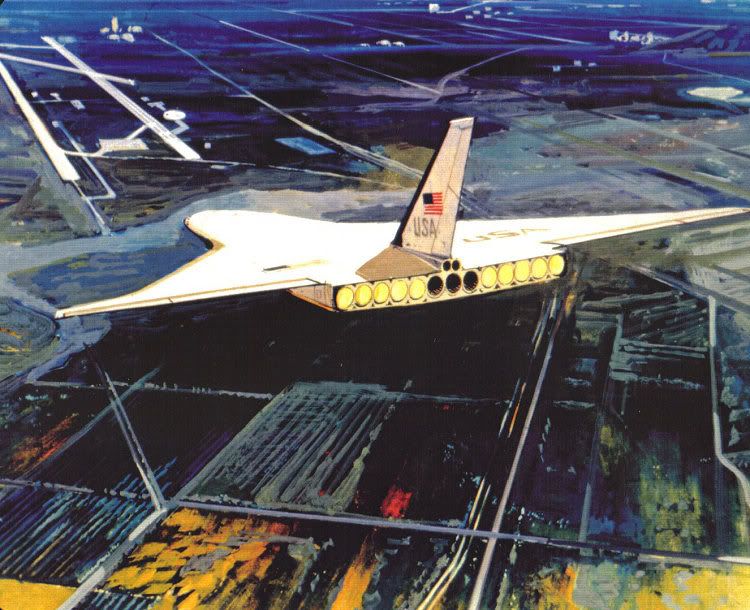
Star-Raker returning to land.
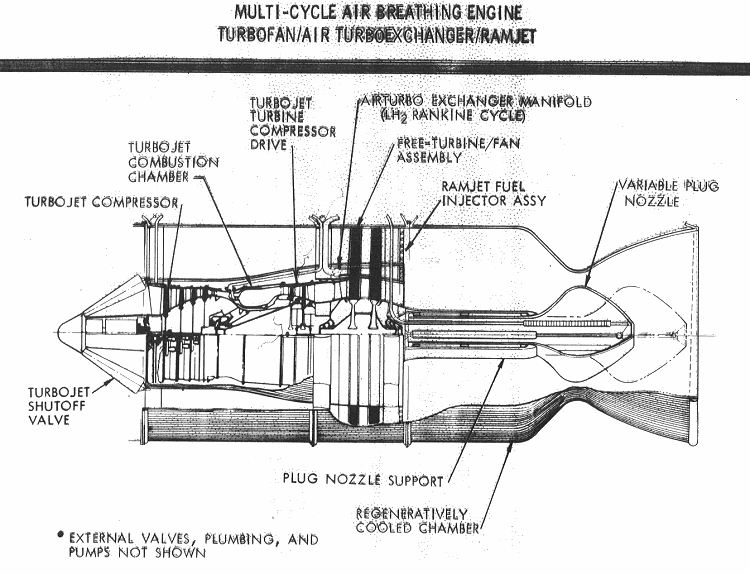
TURBOFANRAMJET!
Payload Specs
1.) Runway takeoff under high-pass turbofan/airturbo exchanger (ATE)/ramjet power, with the ramjets acting as supercharged afterburners.
2.) Jettison and parachute recovery of landing gear used only for launch.
3.) Climb to optimum cruise altitude with turbofan power.
4.) Cruise at optimum altitude, Mach number, and direction vector to earth's equatorial plane, using turbofan power.
5.) Execute a large-radius turn into the equatorial plane with turbofan power.
6.) Climb subsonically at optimum climb angle and velocity to an optimum altitude, using high bypass turbofan/ATE/ramjet (supercharged afterburner) power.
7.) Perform an optimum pitch-over into a nearly constant-energy (shallow Y_angle) dive if necessary, and accelerate through the transonic region to approximately Mach 1.2, using turbofan/ATE/ramjet (supercharged afterburner) power.
8.) Execute a long-radius optimum pitch-up to an optimum supersonic climb flight path, using turbofan/ATE/ramjet power.
9.) Climb to approximately 29 km (95 kft) altitude, and 1900 m/s (6200 fps) velocity, at optimum flight path angle and velocity, using proportional fuel-flow throttling from turbofan/ATE/ramjet, or full ramjet, as required to maximize total energy acquired per unit mass of fuel consumed as function of velocity and altitude.
10.) Ignite rocket engines to full required thrust level at 6200 fps and parallel burn with airbreathing engines to 7200 fps.
11.) Shut down airbreather engines while closing airbreather inlet ramps.
12.) Continue rocket power at full thrust.
13.) Insert into an equatorial elliptical orbit 91 x 556 km (50 x 300 nmi) along an optimum lift/drag/thrust flight profile.
14.) Shut down rocket engines and execute a Hohmann transfer to 556 km (300 nmi).
15.) Circularize Hohmann transfer.
16.) Release Payload or dock with Space Station at that orbit.
17.) Perform delta-v maneuver and insert into an equatorial elliptical orbit 91 x 556 km (50 x 300 nmi) in preparation for re-entry.
18.) Perform a low-gamma (flight path angle), high-alpha (angle of attack) re-entry deceleration profile very similar to Space Shuttle to approximately Mach 6.
19.) Reduce alpha (angle of attack) to appropriate angle for maximum lift/drag ratio for high speed glide and cross range maneuvers to subsonic velocity (Mach 0.85).
20.) Open inlets and start some airbreather engines.
21.) Perform powered flight to landing field, land on runway, and taxi to jetway. Flyback fuel requirements include approximately 300 nmi subsonic cruise and two landing approach maneuvers (first approach waveoff with flyaround for second approach).
Cost? Ha. Don't ask.
This was from a study in the late 1970s that was presented in 1979 formally.

Lockheed Star-Raker and 747 at airport

Star-Raker payload operations

Star-Raker returning to land.

TURBOFANRAMJET!
Payload Specs
- 20 x 20 x 141.5 ft cargo bay (56,600 ft3) accessible via hinged nose
- 196,600 lbs to 300 nm.i at 28.5 deg inclination from Kennedy.
- Deliver above payload at cost of $30-$45 US 2010 Dollars per pound
- Ten hydrogen fueled high bypass supersonic turbofan/air-turbo-exchanger/ramjet engines, each with 140,000 lbf of thrust.
- Three hydrogen fuelled rocket engines, each with 1.06 million lbf of thrust and an ISP of 455 seconds.
- Operate from runways 8,000 to 14,000 ft long (2,440 to 4,270 m).
1.) Runway takeoff under high-pass turbofan/airturbo exchanger (ATE)/ramjet power, with the ramjets acting as supercharged afterburners.
2.) Jettison and parachute recovery of landing gear used only for launch.
3.) Climb to optimum cruise altitude with turbofan power.
4.) Cruise at optimum altitude, Mach number, and direction vector to earth's equatorial plane, using turbofan power.
5.) Execute a large-radius turn into the equatorial plane with turbofan power.
6.) Climb subsonically at optimum climb angle and velocity to an optimum altitude, using high bypass turbofan/ATE/ramjet (supercharged afterburner) power.
7.) Perform an optimum pitch-over into a nearly constant-energy (shallow Y_angle) dive if necessary, and accelerate through the transonic region to approximately Mach 1.2, using turbofan/ATE/ramjet (supercharged afterburner) power.
8.) Execute a long-radius optimum pitch-up to an optimum supersonic climb flight path, using turbofan/ATE/ramjet power.
9.) Climb to approximately 29 km (95 kft) altitude, and 1900 m/s (6200 fps) velocity, at optimum flight path angle and velocity, using proportional fuel-flow throttling from turbofan/ATE/ramjet, or full ramjet, as required to maximize total energy acquired per unit mass of fuel consumed as function of velocity and altitude.
10.) Ignite rocket engines to full required thrust level at 6200 fps and parallel burn with airbreathing engines to 7200 fps.
11.) Shut down airbreather engines while closing airbreather inlet ramps.
12.) Continue rocket power at full thrust.
13.) Insert into an equatorial elliptical orbit 91 x 556 km (50 x 300 nmi) along an optimum lift/drag/thrust flight profile.
14.) Shut down rocket engines and execute a Hohmann transfer to 556 km (300 nmi).
15.) Circularize Hohmann transfer.
16.) Release Payload or dock with Space Station at that orbit.
17.) Perform delta-v maneuver and insert into an equatorial elliptical orbit 91 x 556 km (50 x 300 nmi) in preparation for re-entry.
18.) Perform a low-gamma (flight path angle), high-alpha (angle of attack) re-entry deceleration profile very similar to Space Shuttle to approximately Mach 6.
19.) Reduce alpha (angle of attack) to appropriate angle for maximum lift/drag ratio for high speed glide and cross range maneuvers to subsonic velocity (Mach 0.85).
20.) Open inlets and start some airbreather engines.
21.) Perform powered flight to landing field, land on runway, and taxi to jetway. Flyback fuel requirements include approximately 300 nmi subsonic cruise and two landing approach maneuvers (first approach waveoff with flyaround for second approach).
Cost? Ha. Don't ask.
"If scientists and inventors who develop disease cures and useful technologies don't get lifetime royalties, I'd like to know what fucking rationale you have for some guy getting lifetime royalties for writing an episode of Full House." - Mike Wong
"The present air situation in the Pacific is entirely the result of fighting a fifth rate air power." - U.S. Navy Memo - 24 July 1944
"The present air situation in the Pacific is entirely the result of fighting a fifth rate air power." - U.S. Navy Memo - 24 July 1944
- MKSheppard
- Ruthless Genocidal Warmonger

- Posts: 29877
- Joined: 2002-07-06 06:34pm
Re: What if: Space Shuttle cancellation in 70s
MLV SAT V-25(S)....
A/k/A/ lets strap four 3 segment 156" SRMs to the Saturn V.
(The Space Shuttle uses 4 segment 156" SRMs, BTW).
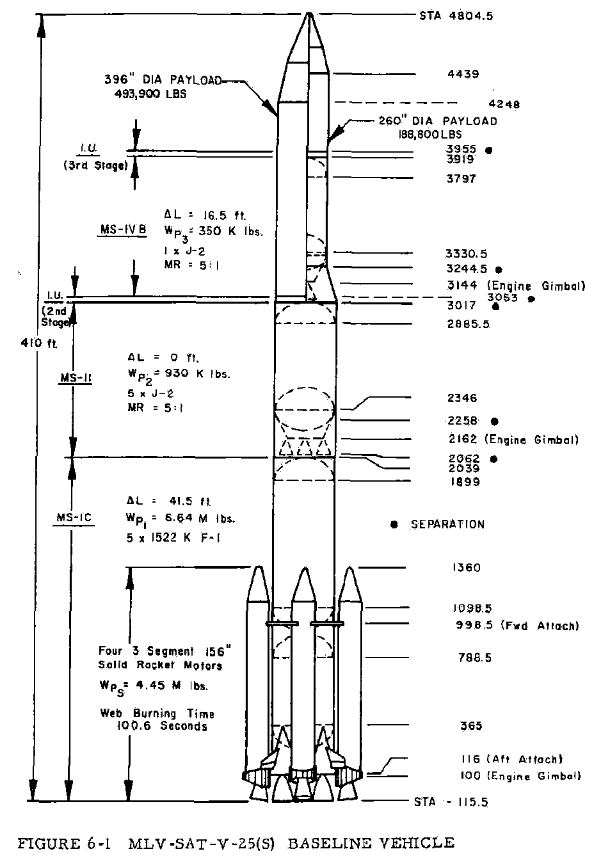
493,900 lbs to LEO.
224 freaking tonnes.
10 Year Production Run at 2 per year:
R&D: $3,779~ million in 2010 Dollars
Test Launches: $3,829~ million in 2010 Dolalrs (MSFC rules require two test flights to man rate)
Average Operational Launch: $1,917.4~ million in 2010 dollars
Total Program Cost for 2 test, 18 operational launches: $38,279~ million in 2010 dollars
10 Year Production Run at 6 per year:
R&D: $3,779~ million in 2010 Dollars
Test Launches: $2,018~ million in 2010 dollars
Average Operational Launch: $1,009~ million in 2010 dollars.
Total Program Cost for 2 test, 58 operational launches: $66,457~ million in 2010 dollars
By contrast, the Space Shuttle Program through 2011 (adjusted for inflation) was $196 billion in 2011 dollars.
FUCKERS. SHITS. I WANT MY MOON BASE!
A/k/A/ lets strap four 3 segment 156" SRMs to the Saturn V.
(The Space Shuttle uses 4 segment 156" SRMs, BTW).

493,900 lbs to LEO.
224 freaking tonnes.
10 Year Production Run at 2 per year:
R&D: $3,779~ million in 2010 Dollars
Test Launches: $3,829~ million in 2010 Dolalrs (MSFC rules require two test flights to man rate)
Average Operational Launch: $1,917.4~ million in 2010 dollars
Total Program Cost for 2 test, 18 operational launches: $38,279~ million in 2010 dollars
10 Year Production Run at 6 per year:
R&D: $3,779~ million in 2010 Dollars
Test Launches: $2,018~ million in 2010 dollars
Average Operational Launch: $1,009~ million in 2010 dollars.
Total Program Cost for 2 test, 58 operational launches: $66,457~ million in 2010 dollars
By contrast, the Space Shuttle Program through 2011 (adjusted for inflation) was $196 billion in 2011 dollars.
FUCKERS. SHITS. I WANT MY MOON BASE!
"If scientists and inventors who develop disease cures and useful technologies don't get lifetime royalties, I'd like to know what fucking rationale you have for some guy getting lifetime royalties for writing an episode of Full House." - Mike Wong
"The present air situation in the Pacific is entirely the result of fighting a fifth rate air power." - U.S. Navy Memo - 24 July 1944
"The present air situation in the Pacific is entirely the result of fighting a fifth rate air power." - U.S. Navy Memo - 24 July 1944
- MKSheppard
- Ruthless Genocidal Warmonger

- Posts: 29877
- Joined: 2002-07-06 06:34pm
Re: What if: Space Shuttle cancellation in 70s
But before we get too caught up....our future time traveler is going to have to have some damn good impeccable credentials.
What kept all these SUPER SATURNS RARVTOLOLROCKETS from being built was...deliberate and outright fraud.
I know that's a strong term, but NASA kept on using deliberately low numbers for per flight costs for SHUTTEL:
In May 1971, they were estimating operational costs of only $27~ million per launch in 2010 dollars for Shuttle.
Even by 31 January 1977, despite the shuttle now being only minimally reusable, the estimates were still pretty low -- the "NASA Recommendations" by the Carter-Mondale Transition Planning Group had STS cost per launch being $50~ million per launch in 2010 dollars.
That's like $770 per pound to orbit for the Shuttle, against $2,040/lb to orbit for MLV-SAT-V-25(S) (4 x 156" SRM), and $2,565/lb to orbit for the MLV Saturn IB-5A (260" SRM).
How the fuck do you argue against GRAEPHS like that?
You could build a thousand ton space station out of shuttle sized modules for $1,540 million with SHUTTEL, versus $4,080 for SUPER STRAP ON SATURN V.
Mangs.
What kept all these SUPER SATURNS RARVTOLOLROCKETS from being built was...deliberate and outright fraud.
I know that's a strong term, but NASA kept on using deliberately low numbers for per flight costs for SHUTTEL:
In May 1971, they were estimating operational costs of only $27~ million per launch in 2010 dollars for Shuttle.
Even by 31 January 1977, despite the shuttle now being only minimally reusable, the estimates were still pretty low -- the "NASA Recommendations" by the Carter-Mondale Transition Planning Group had STS cost per launch being $50~ million per launch in 2010 dollars.
That's like $770 per pound to orbit for the Shuttle, against $2,040/lb to orbit for MLV-SAT-V-25(S) (4 x 156" SRM), and $2,565/lb to orbit for the MLV Saturn IB-5A (260" SRM).
How the fuck do you argue against GRAEPHS like that?
You could build a thousand ton space station out of shuttle sized modules for $1,540 million with SHUTTEL, versus $4,080 for SUPER STRAP ON SATURN V.
Mangs.
"If scientists and inventors who develop disease cures and useful technologies don't get lifetime royalties, I'd like to know what fucking rationale you have for some guy getting lifetime royalties for writing an episode of Full House." - Mike Wong
"The present air situation in the Pacific is entirely the result of fighting a fifth rate air power." - U.S. Navy Memo - 24 July 1944
"The present air situation in the Pacific is entirely the result of fighting a fifth rate air power." - U.S. Navy Memo - 24 July 1944
-
Pelranius
- Sith Marauder
- Posts: 3539
- Joined: 2006-10-24 11:35am
- Location: Around and about the Beltway
Re: What if: Space Shuttle cancellation in 70s
Wow, where do you find these things, Shep?
Excuse while I go off into a corner and cry.
Excuse while I go off into a corner and cry.
Turns out that a five way cross over between It's Always Sunny in Philadelphia, the Ali G Show, Fargo, Idiocracy and Veep is a lot less funny when you're actually living in it.
- Einhander Sn0m4n
- Insane Railgunner
- Posts: 18630
- Joined: 2002-10-01 05:51am
- Location: Louisiana... or Dagobah. You know, where Yoda lives.
Re: What if: Space Shuttle cancellation in 70s
Probably this place. It's useful for tracking aerospace projects all over the world.Pelranius wrote:Wow, where do you find these things, Shep?
Excuse while I go off into a corner and cry.

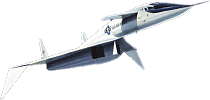
-
Pelranius
- Sith Marauder
- Posts: 3539
- Joined: 2006-10-24 11:35am
- Location: Around and about the Beltway
Re: What if: Space Shuttle cancellation in 70s
Thanks, have thought about registering there, but I already spend way too much on the Internet gadding about here and there.Einhander Sn0m4n wrote:Probably this place. It's useful for tracking aerospace projects all over the world.Pelranius wrote:Wow, where do you find these things, Shep?
Excuse while I go off into a corner and cry.
Turns out that a five way cross over between It's Always Sunny in Philadelphia, the Ali G Show, Fargo, Idiocracy and Veep is a lot less funny when you're actually living in it.
- MKSheppard
- Ruthless Genocidal Warmonger

- Posts: 29877
- Joined: 2002-07-06 06:34pm
Re: What if: Space Shuttle cancellation in 70s
From a book from 1990 called SPACE: THE NEXT 100 YEARS.
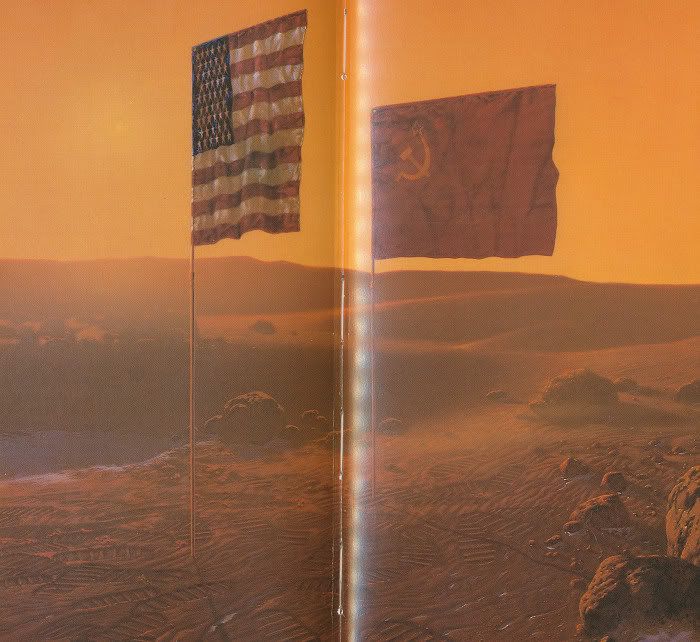
Winter Morning on Mars by Paul Hudson.
I first ran across the book when I was a kid in Junior high school -- it was in my school library; and I recently rediscovered it; and reading it now; there's lots of fun tidbits:

Painting of Hermes docking with Columbus Mini-Station.
Columbus later became an ISS module after much changes I believe.

Winter Morning on Mars by Paul Hudson.
I first ran across the book when I was a kid in Junior high school -- it was in my school library; and I recently rediscovered it; and reading it now; there's lots of fun tidbits:
- As currently envisaged, 18 dedicated shuttle flights starting in March 1995 and finishing by July 1999, will be required to complete construction of the station. Astronauts will not have to wait until then to board Freedom, since a habitable laboratory module, with it's own power supply, should be in place by flight seven in June 1996. By the 12th Shuttle flight in July 1997, enough elements of the vast orbital Lego kit will have been assembled to allow the first crew of eight astronauts to move in.
- Freedom would be in a 300 mile orbit at 28.5 degree inclination; and it would drop to a 62 mile orbit every three months to allow cheap shuttle resupply; at the end of which, it would be reboosted back to the 300 mile orbit.
- Freedom was to be serviced by NASA's Shuttle, ESA's Hermes Spaceplane, and the Japanese Hope Spaceplane.
- Hermes would have made it's first flight in 1998; and on it's 3rd flight would have flown to the ESA's Columbus micro-station, and then flown a Columbus station mission every six months. France had a 43% stake, Germany 27%, Italy 12.1%, and Belgium 5.8%
- They even mention heavy lift vehicles: A variant shown here, Shuttle-C could hoist perhaps 70 tonnes, and it's big brother, the Heavy Lift Launch Vehicle could handle around 120 tonnes. Yet a continent away, such a vehicle already exists: the Soviet Energia booster is capable of lifting 140 tonnes into low earth orbit. NASA could easily adapt it's vehicle elements to be flown atop the Soviet craft.

Painting of Hermes docking with Columbus Mini-Station.
Columbus later became an ISS module after much changes I believe.
"If scientists and inventors who develop disease cures and useful technologies don't get lifetime royalties, I'd like to know what fucking rationale you have for some guy getting lifetime royalties for writing an episode of Full House." - Mike Wong
"The present air situation in the Pacific is entirely the result of fighting a fifth rate air power." - U.S. Navy Memo - 24 July 1944
"The present air situation in the Pacific is entirely the result of fighting a fifth rate air power." - U.S. Navy Memo - 24 July 1944